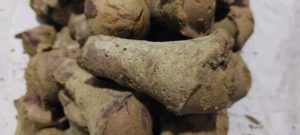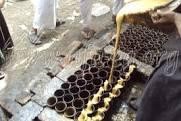Honeycomb, Koz El Assal
The honeycomb making is based on extracting honey from sugar cane, which is widely cultivated in Qena in general and Nagei Hammadi in particular in upper Egypt. The honey cone is one of the popular traditional sweets full of the fragrance of the past. It is an easy handicraft that is based on the ancient origins of work. The honey cone is called “jullab” in the governorates of Nile Delta of Egypt, “honey funnel.” It is a kind of gift. Prepare blackhoney molasses. Honeycomb made in houses or small workshops with a very basic components Diluted blackhoney molasses, sodium carbonate “carbonate” How to make honeycomb – pour blackhoney molasses on the copper pan* and heat until boiling with continuous stirring for 10-12 minutes. – Raise the honey from the copper to the mahlab ** with continuous stirring and the addition of carbonate in a small proportion. – The honey is poured into pottery molds “form” until it takes its well-known shape. – Honey is removed from the pottery molds “form, jizan pottery” *** after ten minutes. – The honeycomb is left in the sun for 30-45 minutes (until her tears drys upon the local expression”), then put in cages and covered with paper. Carbonate has the benefit of lightening the color and making it soft. The black honey used is lighter than the known black honey. The honeycomb is used in some apiaries to feed the bees. The honeycomb factory is called copper. –Honeycomb is a gift in social occasions such as religous feasts and Moulied of muslim and christian saints as well as mariage celebrations–for both children and adults and it is socially forbidden to eat sweets in times of funerals and mortalities, Honeycomb is a cheap sweel usually sold intraditional markets in upper Egypt * Copper: It is the large vessel on which honey is cooked on fire. ** Mahlab: It is a smaller container in which honey is poured after boiling over the copper. *** Pottery molds “Form” are made in Giza area.



